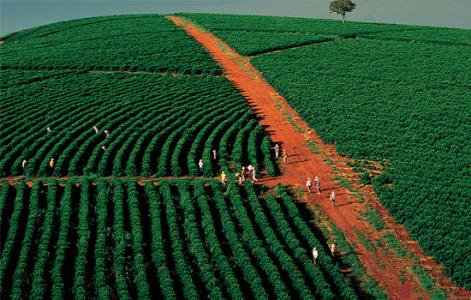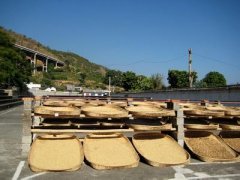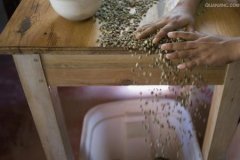A brief introduction to the description of flavor, taste and aroma characteristics of Hawaiian boutique coffee beans with full water

Sunlight: Warm tropical sunlight plays an important role in coffee tree reproduction. Hawaii provides the morning light that Kona Coffee needs.
Cloudiness: The rise of clouds at noon ensures and blocks severe direct sunlight.
Rainfall: Clouds bring plenty of rain, so that coffee after a morning sun, eager to enjoy the afternoon rain moisture baptism.
Slope: A good slope allows the soil to absorb enough water after Kona coffee is made without absorbing too much and affecting the coffee flavor.
planting mode
Kona coffee has always been grown using the family farming model. At first, only men were allowed to work in coffee gardens, but later women joined in. Hawaiian family production was more dependent on family effort than on hiring workers, so it was normal for Hawaiian families to have eight or nine children.
Since then, new immigrants from the Philippines, the United States and Europe have come to Hawaii to engage in coffee farming. Over time, Hawaii has formed a social atmosphere centered on family culture and easy to absorb foreign culture, which has become a major feature of Hawaii.
The harvest season for Kona coffee begins in late August and lasts until January. Farmers harvest the ripe fruit in batches and process it to produce beans
Hawaii's earliest settlers arrived between 300 and 400 AD, and historians speculate that they came from the Marquesas Islands. The people lived on the island in separate tribes led by hereditary chiefs. The earliest Hawaiian inhabitants created Hawaii's rich musical culture, although not much writing survives.
The Europeans discovered Hawaii by accident. They were originally looking for a legendary passage to the east to produce spices, but instead they found the richest pearl in the Pacific Ocean. A captain named James Cook landed on Kauai in 1778 to supply his ships. He encountered severe cold and storms on his way back, and had to return to Hawaii early the following year and anchor on a beach in Kona. Since then, the Hawaiian Islands have become important stopovers on the world trade routes. Hawaii's chiefs traded sandalwood, a native of the island, for weapons, goods and livestock with passing ships. From the 1820s, Western religion began to spread widely on the island, and many churches built in that era are still in use today.
Hawaii's tourism industry is developed. Visitors can visit coffee farms, see or participate in various processes such as coffee harvesting, coffee bean processing, roasting and grinding, and make a cup of coffee that really belongs to them. There are about 600 independent coffee farms in the Kona area, most of which are small family farms, usually between 18 and 42 acres. Kona coffee can bring in more than $10 million a year to these coffee farms.
Kona coffee has always been grown using the family farming model. At first, only men were allowed to work in the coffee garden, but later women joined in. Hawaiian family production was more dependent on family effort than on hiring workers, so it was normal for Hawaiian families to have eight or nine children. Since then, new immigrants from the Philippines, the United States and Europe have come to Hawaii to engage in coffee farming. Over time, Hawaii has formed a social atmosphere centered on family culture and easy to absorb foreign culture, which has become a major feature of Hawaii.
Hawaii is also a paradise for coffee tasting and buying. Each island has several unique places for tourists and locals to taste and buy coffee, ranging from cozy shops to comprehensive coffee knowledge centers. Real Hawaiian Kona coffee gives you a unique pleasure and leads you slowly into the transcendent state of coffee tasting. And this is all from the oldest Arabica coffee tree.
Hawaii is the only state in the United States to grow coffee, which is grown on the five main islands of the Hawaiian archipelago: Oahu, Hawaii, Maui, Kauai and Mauroka. Coffee produced on different islands also has its own characteristics. Coffee from Kauai is soft and smooth, coffee from Mauroka is high in alcohol and low in acidity, and coffee from Maui is medium in acidity but has the strongest flavor. Hawaiians are proud of their 100% indigenous Arabica coffee beans.
Kona coffee is suitable for the location and climate. Coffee trees grow on volcanic slopes, and their location ensures the altitude at which coffee grows; dark volcanic ash soils provide the minerals coffee needs. This is probably due to Kona's abundance of volcanic black mud, which is moderately acidic, mineral-rich, and contains the right amount of water. And every afternoon, a cloud drifts over Kona Island to block out the sun to protect the fragile coffee saplings.
The weather conditions are so favourable that the sun gently passes through the steamy air in the morning, the mountains become wetter and foggy in the afternoon, the clouds surge in the air as natural umbrellas for coffee trees, and the nights become clear and cool. Natural conditions allow the average yield of Kona coffee to be very high, reaching 2240 kg/ha, compared with 600 - 900 kg/ha in Latin America.
Kona coffee is grown without shade, and Hawaii has an island climate, which often has a dark cloud that forms a shadow effect. Hawaiian coffee farmers tend to prepare their plantations for a climate that is reasonably clean, fertile, and carefully managed by farmers. Making Kona coffee the specialty coffee on the market. [1]
factors covered
Kona coffee
Kona Coffee)
Soil: The rich tropical volcanic soil of Hawaii provides the nutrients of the dense Kona coffee tree.
Altitude: The right altitude between 2100 and 3600 meters and the cool moonlight promote the slow ripening of Kona coffee fruits and create a rich, moist taste.
Important Notice :
前街咖啡 FrontStreet Coffee has moved to new addredd:
FrontStreet Coffee Address: 315,Donghua East Road,GuangZhou
Tel:020 38364473
- Prev

A brief introduction to the treatment method of grinding degree and baking degree of Colombian boutique coffee beans mixed with sour and sweet fruits
As for the color of the bean body, the growing environment of coffee beans and the processing technology of raw beans will affect the color of coffee beans. If the same kind of coffee beans produced on the same plantation are treated differently, for example, one batch is washed with water and the other batch is treated with honey, then the colors of the two batches of beans will be very different. Generally speaking, the density of bean body is the best way to judge the growth of coffee beans at altitude.
- Next

A brief introduction to the Origin, Development, History and Culture of Hawaiian Fine Coffee beans full of Flower scent
Of all the coffee producers, Hawaii has the most stringent management of the coffee industry, the highest labor costs and the best level of investment. Hawaii's coffee industry has to compete with the expanding tourism industry. Most coffee is grown on the slopes of MaunaLoa. Mauna Loa was originally a volcano located in the western part of the Kona region on the island of Hawaii. The
Related
- Detailed explanation of Jadeite planting Land in Panamanian Jadeite Manor introduction to the grading system of Jadeite competitive bidding, Red bid, Green bid and Rose Summer
- Story of Coffee planting in Brenka region of Costa Rica Stonehenge Manor anaerobic heavy honey treatment of flavor mouth
- What's on the barrel of Blue Mountain Coffee beans?
- Can American coffee also pull flowers? How to use hot American style to pull out a good-looking pattern?
- Can you make a cold extract with coffee beans? What is the right proportion for cold-extracted coffee formula?
- Indonesian PWN Gold Mandrine Coffee Origin Features Flavor How to Chong? Mandolin coffee is American.
- A brief introduction to the flavor characteristics of Brazilian yellow bourbon coffee beans
- What is the effect of different water quality on the flavor of cold-extracted coffee? What kind of water is best for brewing coffee?
- Why do you think of Rose Summer whenever you mention Panamanian coffee?
- Introduction to the characteristics of authentic blue mountain coffee bean producing areas? What is the CIB Coffee Authority in Jamaica?

